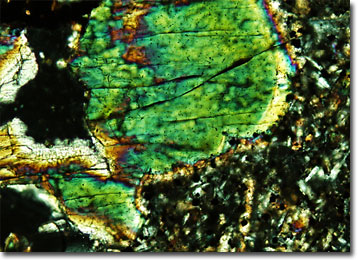Polarized Light Microscopy Digital Image Gallery
Leucite Nepheline Tephrite
Leucite is a feldspathoid mineral that can be found only in igneous rocks. The luster of the mineral is vitreous to dull and its name derives from the Greek word for “white,” its most typical color.

Leucite is relatively rare, but some of the most notable occurrences are found in Uganda, Rome, and Wyoming. The potassium aluminosilicate, however, is an economically significant mineral, gaining use in Italy as a fertilizer and as a supply of alum. Leucite-rich rocks are generally classified and named based upon the other mineral constituents they contain. Leucitite, for instance, is characterized by the absence of olivine and plagioclase feldspar, while olivine is present in leucite-basalt, but plagioclase is not.
Leucite-tephrite is a type of igneous rock in which olivine is absent and plagioclase feldspar is present. When nepheline, the most common feldspathoid mineral in the world, also occurs in the rock, the basalt is described as a leucite nepheline tephrite. Similar to leucite, nepheline is sometimes utilized for commercial purposes, primarily as a substitute for feldspar in the production of ceramic and glass items. Extremely rare, leucite nepheline tephrite, which may exhibit an aphanitic to porphyritic texture, is best known from Hamberg, Germany.
